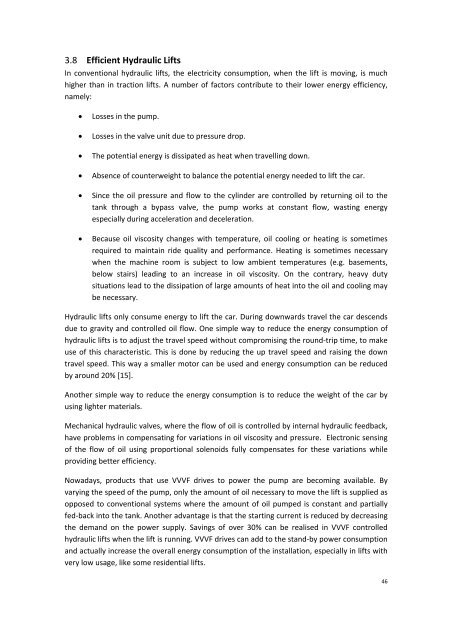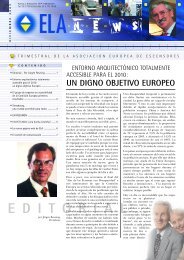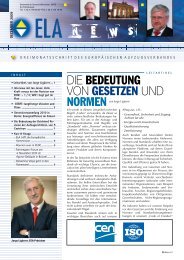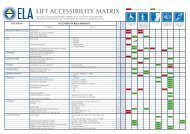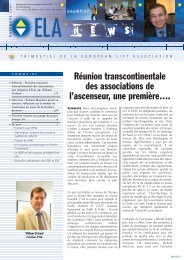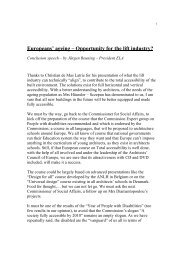WP6-Brochure-E4 brochure - ELA European Lift Association.
WP6-Brochure-E4 brochure - ELA European Lift Association.
WP6-Brochure-E4 brochure - ELA European Lift Association.
Create successful ePaper yourself
Turn your PDF publications into a flip-book with our unique Google optimized e-Paper software.
3.8 Efficient Hydraulic <strong>Lift</strong>s<br />
In conventional hydraulic lifts, the electricity consumption, when the lift is moving, is much<br />
higher than in traction lifts. A number of factors contribute to their lower energy efficiency,<br />
namely:<br />
• Losses in the pump.<br />
• Losses in the valve unit due to pressure drop.<br />
• The potential energy is dissipated as heat when travelling down.<br />
• Absence of counterweight to balance the potential energy needed to lift the car.<br />
• Since the oil pressure and flow to the cylinder are controlled by returning oil to the<br />
tank through a bypass valve, the pump works at constant flow, wasting energy<br />
especially during acceleration and deceleration.<br />
• Because oil viscosity changes with temperature, oil cooling or heating is sometimes<br />
required to maintain ride quality and performance. Heating is sometimes necessary<br />
when the machine room is subject to low ambient temperatures (e.g. basements,<br />
below stairs) leading to an increase in oil viscosity. On the contrary, heavy duty<br />
situations lead to the dissipation of large amounts of heat into the oil and cooling may<br />
be necessary.<br />
Hydraulic lifts only consume energy to lift the car. During downwards travel the car descends<br />
due to gravity and controlled oil flow. One simple way to reduce the energy consumption of<br />
hydraulic lifts is to adjust the travel speed without compromising the round‐trip time, to make<br />
use of this characteristic. This is done by reducing the up travel speed and raising the down<br />
travel speed. This way a smaller motor can be used and energy consumption can be reduced<br />
by around 20% [15].<br />
Another simple way to reduce the energy consumption is to reduce the weight of the car by<br />
using lighter materials.<br />
Mechanical hydraulic valves, where the flow of oil is controlled by internal hydraulic feedback,<br />
have problems in compensating for variations in oil viscosity and pressure. Electronic sensing<br />
of the flow of oil using proportional solenoids fully compensates for these variations while<br />
providing better efficiency.<br />
Nowadays, products that use VVVF drives to power the pump are becoming available. By<br />
varying the speed of the pump, only the amount of oil necessary to move the lift is supplied as<br />
opposed to conventional systems where the amount of oil pumped is constant and partially<br />
fed‐back into the tank. Another advantage is that the starting current is reduced by decreasing<br />
the demand on the power supply. Savings of over 30% can be realised in VVVF controlled<br />
hydraulic lifts when the lift is running. VVVF drives can add to the stand‐by power consumption<br />
and actually increase the overall energy consumption of the installation, especially in lifts with<br />
very low usage, like some residential lifts.<br />
46


